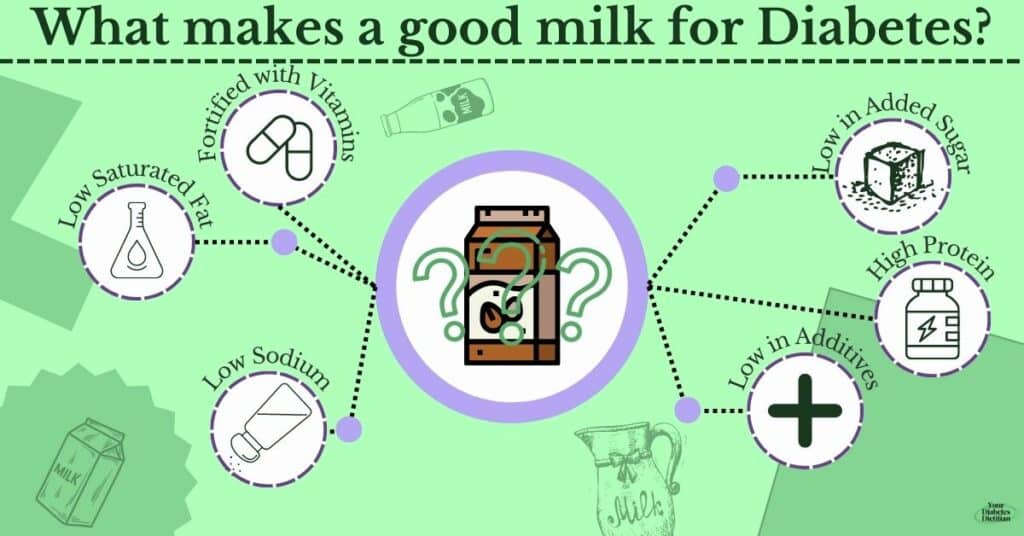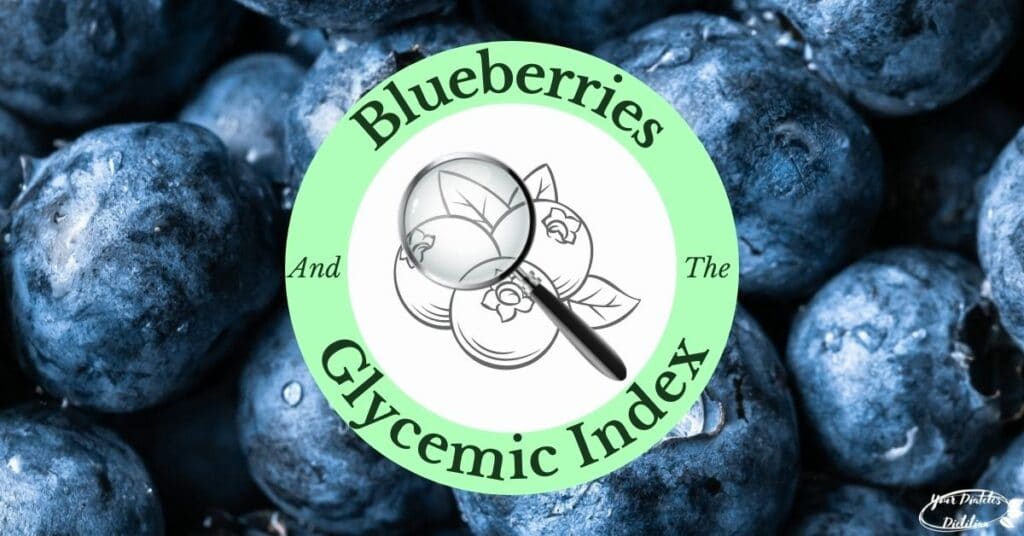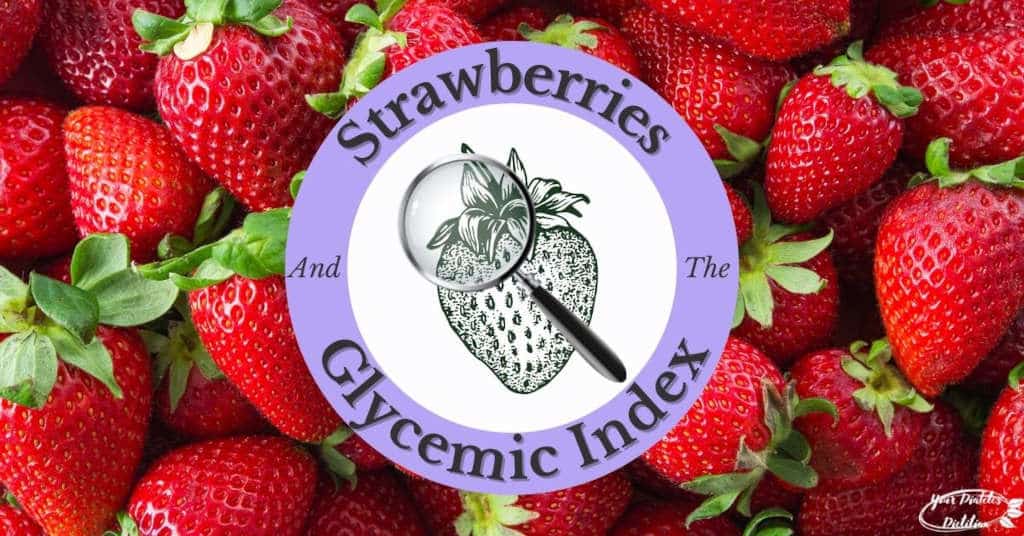Lactose intolerance, a rise in plant-based eating, and concerns about high cholesterol are all big reasons why people are looking to non-dairy milk products. And with all the plant-based milk options out there, are you wondering which one is the best to buy? Almond milk is certainly popular, but is it good for diabetes?
How well does almond milk stack up against other milks? If you’re a big fan and you’re wondering if almond milk is good for diabetes, keep reading.
DISCLAIMER: This post was written by Justine Chan MHSc, RD, CDE. All content on this site is for informational purposes only and is not a substitute for professional medical or nutritional advice. Always seek medical and dietary advice from your doctor or dietitian.

So, let’s get into whether almond milk is good for diabetes, its nutrition facts, and health benefits.
All nutrition information is sourced either through food labels or through the USDA Nutrient Database.
Table of Contents
Nutrition scorecard
1 cup of unsweetened, shelf stable almond milk provides:
- 39kcal
- 3 grams of carbohydrates
- 0.5 grams of fiber
- 1 gram of protein
- 3 grams of fat
- 482 milligrams of calcium (37% Daily Value)
- 0.7 milligrams of iron (4% Daily Value)
- 16 milligrams of magnesium (4% Daily Value)
- 176 milligrams of potassium (4% Daily Value)
- 24 milligrams of phosphorus (2% Daily Value)
- 0.2 milligrams of zinc (2% Daily Value)
- 0.03 milligrams of vitamin B2 (2% Daily Value)
- 3 micrograms of vitamin D (15% Daily Value)
- 17 milligrams of vitamin E (110% Daily Value)
Comparing types of Almond Milk
Let’s compare this to a few common types of almond milk. If you look at the chart below, then you will see that there can be a wide variation in nutrients even within the almond milk product line. Carb count can range between 1 and 20 grams, so it’s important to read the labels.
| Unsweetened | Sweetened vanilla | Unsweetened chocolate | |
| Calories (kcal) | 39 | 91 | 50 |
| Carbohydrates (g) | 3 | 16 | 3 |
| Fibre (g) | 0.5 | 1 | 1 |
| Protein (g) | 1 | 1 | 2 |
| Fat (g) | 3 | 3 | 4 |
| Calcium (mg) | 482 | 451 | 451 |
| Iron (mg) | 0.7 | 0.7 | 0.1 |
| Magnesium (mg) | 16 | 17 | 24 |
| Potassium (mg) | 176 | 120 | 230 |
| Phosphorus (mg) | 24 | 19 | 41 |
| Zinc (mg) | 0.2 | 1.5 | 0.2 |
| Riboflavin (mg) | 0.03 | 0.4 | 0.1 |
| Vitamin D (µg) | 3 | 2 | 2 |
| Vitamin E (mg) | 17 | 7 | 10 |
Comparing almond milk to other milks
How does almond milk compare to other milks overall? Take a look below to find the nutrition profile of other popular milks in comparison to unsweetened almond milk.
| Unsweetened almond | Soy | Oat | Coconut | Cow, 2% | |
| Calories (kcal) | 39 | 105 | 115 | 75 | 122 |
| Carbohydrate (g) | 3 | 12 | 12 | 7 | 12 |
| Fibre (g) | 0.5 | 0.5 | 2 | 0 | 0 |
| Protein (g) | 1 | 6 | 2 | 0.5 | 8 |
| Fat (g) | 3 | 4 | 7 | 5 | 5 |
| Calcium (mg) | 482 | 300 | 300 | 451 | 309 |
| Iron (mg) | 0.7 | 1 | 0.6 | 0.7 | 0 |
| Magnesium (mg) | 16 | 37 | 14 | 0 | 29 |
| Potassium (mg) | 176 | 298 | 355 | 46 | 390 |
| Phosphorus (mg) | 24 | 105 | 214 | 0 | 252 |
| Zinc (mg) | 0.2 | 0.6 | 0.2 | 0 | 1 |
| Riboflavin (mg) | 0.03 | 0.4 | 0.7 | 0 | 0.3 |
| Vitamin D (µg) | 3 | 3 | 4 | 2 | 3 |
| Vitamin E (mg) | 17 | 0.2 | 0.2 | 0 | 0.07 |
The key observation is that almond milk is lowest in calories and carbohydrates, making it a great hydration choice for people with diabetes!

To expand on plant based beverages a little further, let’s divide them into the following groups. The carb count below is based on unsweetened products, from highest to lowest:
- Cereal based, 12 to 26 grams of carbohydrates per cup: oat, rice
- Legume based, 6 to 12 grams of carbohydrates per cup: soy, pea
- Vegetable based, 1 gram of carbohydrates per cup: potato
- Seed based, 0 to 5 grams of carbohydrates per cup: flax, hemp
- Nut based, 0 to 2 grams of carbohydrates per cup: almond, cashew, coconut
That is some major choice overload! Gone are the days when cow’s milk was the only option. As you can see, rice milk is the highest in carbohydrates, while nut based milks tend to be the lowest.
Additives in almond milk
Food manufacturers have a tough job making plant-based beverages like almond milk taste as close to cow’s milk as possible. Almond milk is made up mostly of water, with emulsifiers like locust bean gum and gellan gum used as thickening agents. They also help to keep the plant protein suspended in the milk (1).
It’s also common to find additives and added sugar as ingredients, especially in almond milk that is shelf stable and can be stored for extended periods of time. Sweetened almond milk often contains cane sugar as the second ingredient.
How does it compare to other kinds of milk?
As discussed, almond milk is known for its low calorie and carb count, compared to oat and cow’s milk (2, 3). This is because 69% of its calories come from fat, particularly the healthy monounsaturated and polyunsaturated kinds.
Almond milk is also notorious for being lower in protein compared to cow’s milk.
However, there are new products out there, including a higher protein kind that has 10 grams of pea protein per cup.
Fortification and benefits of plant based beverages
Fortification of vitamins and minerals is inconsistent and sometimes these nutrients are missing from nutrition labels. This means that they are either not present or present in trace amounts.
An international analysis of plant based beverages found that fortified almond and coconut beverages had the lowest amount of vitamin D (1). However, this analysis also found the highest amounts of vitamin B12 and calcium in almond beverages. Great news, especially if you’re vegetarian!
The bottom line is if you’re eating a well-rounded diet, you are at a lower risk of developing vitamin and mineral deficiencies down the road when choosing almond milk.

Potential benefits of plant-based beverages like almond milk include (4):
- stronger immune system
- potential antibacterial effects
- possible protection against cardiovascular, gastrointestinal, and neurodegenerative disease
- preserved bone mass
- lowering cholesterol and risk for heart disease
How is almond milk made?
Eighty percent of the almonds produced today worldwide come from California (5). First, the almonds are milled into a fine slurry. Next, ingredients like sugar, oil, flavorings, and stabilizers are added. The mixture is then homogenized and pasteurized, and then sprayed into a powder to increase shelf life (4).
Impact on environment
One liter of plant based milk produces nearly 19 times less carbon emissions than cow’s milk (4). It’s estimated that almond milk and other plant based beverages contribute only 22 to 38% of the greenhouse gas emissions from cow’s milk (1)
However, almond milk production requires significantly more water (5). It’s estimated that 175 liters of water is needed to produce one liter of almond milk (5), with some studies claiming that number can go up to 6100 liters of water per liter (4). In comparison, cow’s milk uses up to 1030 liters per liter (4).
It’s also been reported that almond farming has negatively impacted pollination from bees (1).
Does almond milk raise blood sugar?
As we’ve seen, almond milk, if unsweetened, is mostly water and very low in carbs, so there should be a minimal impact on your blood sugars. If you choose vanilla or chocolate flavored almond milk, you’re looking at 16 to 20 grams of carbohydrates. This is still lower than chocolate cow’s milk which has 25 to 30 grams of carbohydrates per 250ml cup.
Unsweetened almond milk has a glycemic index (GI) of 25 (6) which puts it in the low category. Foods and beverages that are low on the glycemic index tend to gradually increase blood sugars rather than cause a spike.
The studies on almond milk are limited, but there was one cross-over study where 22 people with type 2 diabetes were given either almond milk or cow’s milk with a serving of oatmeal (7). There was no difference 4 hours post meal on blood sugars, gut hormones, or fats released into the study participants’ bloodstream.

Benefits of almonds
Almonds are high in antioxidants, and are also a great source of B-vitamins and vitamin E (8). One unique advantage as seen above is that almond milk can provide 50 to over 100% of your daily recommended amount of vitamin E. Vitamin E is known for its potential role in healthy aging as an antioxidant, in the prevention of chronic diseases, as well as immune health.
Research indicates that the regular consumption of almonds can lead to:
- A lower HbA1c, according to a systematic review (9).
- Better digestive health, since the fiber in almonds act as food for your healthy gut bacteria (10)
- Improved blood pressure
- Reduced cholesterol (11)
- Weight loss (10, 11)
- Better sleep, memory, concentration, and mental alertness (12)
For more information on the benefits of almonds, check out this post on almond flour.
Can people with diabetes have almond milk?
If you think of the Diabetes Plate method, unsweetened almond milk, while not technically calorie free, would likely count as #4. It’s mostly water and strained almonds but because it is heavily diluted, it’s more of a beverage than a source of protein.
Choose the unsweetened kind for a lower carb count and also a lower blood sugar spike. Almond milk fortified with pea protein is also a great option.
Staying well hydrated is especially important because it helps to dilute the sugar in your bloodstream. If water just isn’t doing it for you, a glass of almond milk can be just as hydrating and can count towards your daily fluid goal.
How do you know whether you are drinking enough? A general rule of thumb is to divide your weight in pounds by half. This is the number of ounces you need daily. So if you weigh 150lbs, you would aim to drink 75 ounces or just over 2 liters per day.
However, if you have heart disease or kidney disease, you may need to restrict your fluids. The renal dietitians I work with recommend ½ to 1 cup almond beverage daily. This almond milk provides 8 grams of carbohydrate per 250ml cup and is low in phosphorus.
How to select milk for diabetes
All types of milk can fit in your meal plan based on your preference, provided they are unsweetened.
In general, a milk that’s good for diabetes should be:
- Low in unsaturated fat
- Low in sodium, with less than 5% Daily Value or 115 milligrams per serving
- Low in added sugars, less than 20% Daily Value or 10 grams per serving
- Low in additives
- Fortified with key vitamins like calcium, vitamin D, and B12
- A source of protein
Soy milk has the most balanced nutritional profile and is comparable to cow’s milk in terms of protein and other nutrients.
Almond milk and flax milk are both low in carbs and calories at less than 100 calories per 250ml. They also contain heart healthy fats which can help to reduce cholesterol.
Fortified and unsweetened soy, almond, and flax milk are all great plant-based options that meet the above criteria! Of course, low fat cow’s milk is also fine for people with diabetes. If you’re looking for another option, this cow’s milk has 50% more protein and 50% less sugar than regular milk.

Almond milk and cholesterol
Almond milk is low in saturated fat, with one cup containing only trace amounts. Also, the fats in almond milk are mostly monounsaturated.
This is the same type of fat that makes the Mediterranean Diet so good for you. If you didn’t know, the Mediterranean diet is well established in promoting cardiovascular benefits and longevity.
Also, the gums that are commonly used in the almond milk are helpful in managing blood sugars and cholesterol. They act like a water soluble fiber, attracting water and forming a gel during digestion (1). Because of this, the end result is less blood sugar spikes and lower cholesterol.
Choosing the unsweetened kind is ideal, since too much added sugars in your diet can also increase your triglycerides, a type of fat in your blood. High triglycerides can increase your risk of a heart attack or stroke.
Side effects
If you have a nut allergy, then almond milk isn’t for you.
Based on how almond milk production is mass produced, it does require a significant amount of water to make. However, the general consensus is that it still has less of an environmental impact compared to cow’s milk.
Because of its low protein content, almond milk that has less than 5 grams of protein per serving is not ideal for growing children (1, 13).
If you have a history of kidney stones from oxalate crystals, almond milk is one of the highest in oxalates compared to other plant based milks (14)
However, drinking enough fluids is one of the best strategies to reduce your risk of kidney stones. Also, choosing an almond milk fortified with calcium can help to bind the oxalate so less of it gets in your urine.

How to store and use almond milk
At the grocery store, almond milk can be found in the aisles to be kept at room temperature or in the refrigerated section.
You can also make your own by soaking almonds and then blending them in a food processor.
Almond milk can be used for:
- Smoothies
- Oatmeal and cereal
- Lattes and other specialty beverages
- As a sweetener for your coffee
- Creamy dishes like mashed potato
Key takeaways: Is almond milk good for diabetes?
So far, this post has examined the nutritional profile of almond milk, how it compares to other common milks, and whether almond milk is good for diabetes.
We have seen how almond milk has a much lower environmental footprint, and is generally a low calorie and low carb option.
Since fortification is so inconsistent across the board, it is best to look for almond milk that contains key vitamins like calcium, vitamin D, and vitamin B12. There are now higher protein options available that are also great for diabetes!
For more exclusive tips that I share with my email list only, be sure to sign up below.





Everythning iss very open wiith a clear clrification of the issues.
It was definitel informative. Your sijte iss verty useful.
Thank youu for sharing!
Fantastuc blog! Do you have aany recommendations for aspiring writers?
I’m planning tto start my oown blog soon but I’m a littrle lst on everything.
Woould you recommeend startin wiith a free platform liike Wrdpress or goo ffor a paid option? There aree sso
many optiokns outt there tha I’m totally overwhelmed ..
Any recommendations? Thanks a lot!